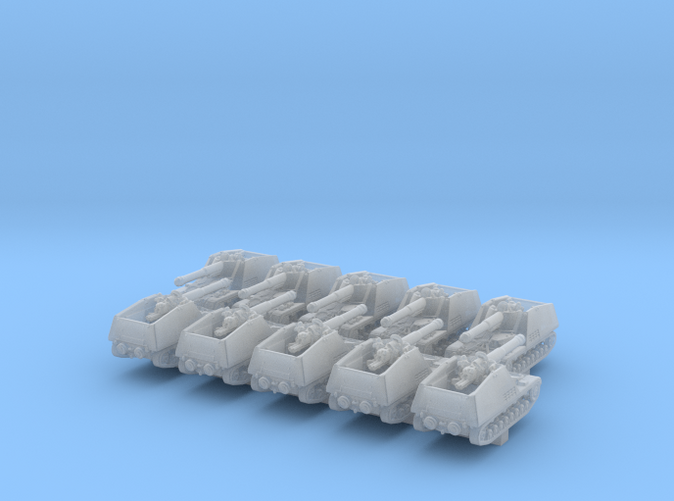1/600 Scale WW2 German Army Nashorn Tank Destroyer.
Contains 10 highly detailed tanks.
Contains:
10x German Nashorn Tank Destroyers
Nashorn Tank Destroyer
Nashorn (
German "
rhinoceros", pronounced [ˈnaːshɔɐ̯n]), initially known as
Hornisse (
German "
hornet"), was a
German tank destroyer of
World War II. It was developed as an interim solution in 1942 by equipping a light turretless chassis with the
Pak 43 heavy anti-tank gun. Though only lightly armoured and displaying a high profile, it could frontally penetrate any Allied tank at long range, and its relatively low cost and superior mobility to heavier vehicles ensured it remained in production until the war's end.After the first German experiences with the newer
Soviet tanks like the
T-34 or the
Kliment Voroshilov tank during
Operation Barbarossa, the need for a
Panzerjäger capable of destroying these more heavily armoured tanks became clear.
In February 1942, the
Alkett (
Altmärkische Kettenwerke GmbH) arms firm of Berlin designed a tank destroyer using their recently developed
Geschützwagen III/IV which as its name indicated used components of both the
Panzer III and
Panzer IV tank. The
8,8 cm Panzerjägerkanone 43/1 L/71 (or shortly
Pak 43/1), a long-barreled anti-tank gun more known as the main armament of the
Tiger II, was mounted on the rear of the chassis complete with its gun shield and an open-topped superstructure was built up around the gun to give the crew some protection. The gun had the same traverse and elevation as if it had been on its carriage: 15° to either side and between -5° to +15° elevation. To accommodate the long and heavy gun, the hull had to be lengthened and the engine moved from the rear to the centre of the chassis. The amount of armour provided for the crew compartment was limited. The shielding provided was adequate to protect the crew from blast and small arms, but not armour piercing rounds. Thus, like the Marder series weapons, the vehicle was not intended to engage in tank fights, but to provide mobility to a powerful anti-tank gun.
This model was presented for approval to
Adolf Hitler in October 1942 and entered production in early 1943. It had numerous official designations, such as
8,8 cm Pak 43 (L/71) auf Fahrgestell Panzerkampfwagen III/IV (Sf) or
8,8cm Pak43 (L/71) auf Geschützwagen III/IV (Sd. Kfz. 164), though it was also known as the
Panzerjäger Hornisse (in English "Tank-hunter Hornet")
During the first half of 1943, a new model of the
Hornisse was introduced into production. This model altered the driver's front armour plate, along with other minor differences. This model and its predecessor, the few early production vehicles, were almost indistinguishable. It was renamed
Nashorn by Hitler in 1944.
Total production of the
Nashorn amounted to some 494 vehicles, most of which were built in 1943. In January 1944, Hitler favored production of a newer tank destroyer, the
Jagdpanzer IV, which had a much lower silhouette, thicker frontal armor (60 mm frontal plate), and an effective though less powerful 7.5 cm gun. Though still primarily an ambush weapon, this vehicle was better built for armoured engagements. Production of the
Nashorn continued into 1945, though at a slow pace.
There are two
Nashorns on display in military museums: at the
United States Army Ordnance Museum and at the
Kubinka Tank Museum. A third "Nashorn" is under restoration to running status, in private hands in England.
Cleaning Information
Some part cleanup will be necessary. The 3D printing process uses a waxy substance to support certain part features during the printing process. Although the parts are cleaned by Shapeways, some waxy residue may remain. It can be safely removed with water and a mild aqueous detergent like "Simple Green" using an old, soft toothbrush, Q-tips or pipe cleaners. During the printing process, liquid resin is cured by ultraviolet light. Microscopic bits of resin may remain uncured.
Let your parts sit in direct sunlight for a few hours to fully cure the resin.
Water-based acrylic paints meant for plastics is strongly recommended. Other paints, especially enamels, may not cure on Frosted Detail 3D-printed plastics.
Use dedicated model sprue cutters to remove parts to minimise the risk of damage to parts.
Please take a look at my other items.
Painting tips and preparation
